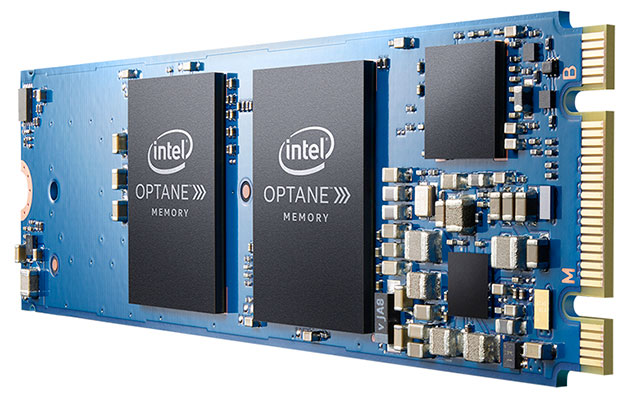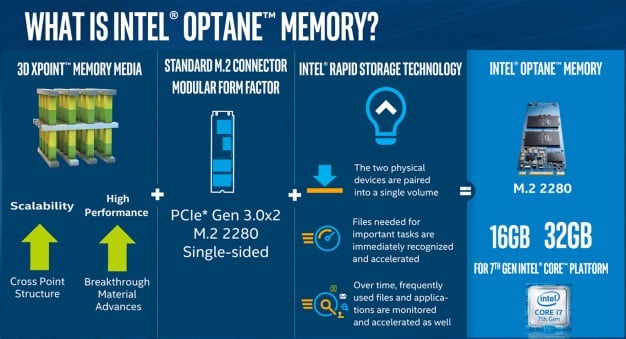Intel Optane Memory With 3D XPoint Technology Caches Slower Drives For A Performance Boost
Introducing Intel Optane Memory
Early last week, Intel revealed its Optane SSD DC P4800X featuring 3D Xpoint memory technology. The Optane SSD DC P4800X is an enterprise-class product, targeted at data centers and mission-critical applications where reliable, ultra-low-latency access to large amounts of data is paramount. Today, Intel is introducing another new product featuring 3D Xpoint memory, but this is one quite literally at the other end of the spectrum. The Intel Optane Memory devices we’ll be discussing here looks like other current generation 80mm M.2 “gumstick” type solid state drives. However, Intel Optane Memory is meant to be used as an accelerator for systems featuring relatively low-speed storage devices, like hard drives.
Intel Optane Memory products and their associated software are designed to cache the most frequently accessed bits of data on a compatible system, which can significantly increase performance and responsiveness, if said system is equipped with a slower drive. If that sounds familiar – it should. The implementation is very similar to Intel’s original Smart Response Technology, which debuted all the way back when the SSD 311 series of SATA-based solid state drives was released. In fact, one of the pieces of software included with Intel Optane Memory will still carry the Smart Response Technology moniker.
To recap, Intel Smart Response Technology is a caching mechanism that uses a solid state drive – like Intel Optane Memory -- to enhance overall system performance and simplify the drive configuration presented to the end-user in the OS. The SSD can be paired to any standard hard drive or SATA drive for that matter, regardless of the capacity. The Optane Memory is then used as a high-speed repository of the most commonly accessed data blocks (not necessarily complete files). Usage patterns on the hard drive are monitored and the most frequently accessed bits of data are copied from the hard drive to the SSD. Because the SSD is used as a cache, it is not presented to the end-user as a separate volume. It works transparently in the background, which can help less-savvy users not accustomed to managing multiple drives.
Like other SSD / HD hybrid storage technologies, the data on the hard drives has to be accessed multiple times before it is copied to the solid state storage volume. So, the contents of the SSD will dynamically and constantly change over time, based on usage patterns. The most commonly accessed data on the platters gets copied to the much higher performing SSD, which results in a performance boost when that data needs to be fetched.
Knowing how Smart Response technology works, reveals one of the drawbacks of a hybrid setup—the Intel Optane Memory or other SSD will offer little or no performance benefit to infrequently accessed or new data. So, with large file copies, application installations, and the like, a system with Smart Response enabled may perform much like it had only a standard HD inside. With that said, a significant portion of the data being cached on the SSD will be parts of the OS/Windows. So, although brand new data introduced to the system must be accessed more than once to be considered by the caching algo, the system will almost always seems faster and more responsive, because bits of the OS itself are cached.
The first products in Intel’s Optane Memory line-up will be M.2 “gumstick” type NVMe SSDs, with capacities of 16GB and 32GB. The sticks themselves look rather simple, with only one (16GB) or two (32GB) 3D Xpoint memory media packages populating one side of the device, along with the Intel-made controller and a few other surface mounted components.
The main features and specifications of Intel’s Optane Memory products are outlined in the table above. What you’ll notice is that, like the Optane SSD DC P4800X, Optane Memory offers relatively high performance at low-queue depths, which are most common in desktop client computing workloads. Sequential read/writes are 1.2GB/s and 280MB/s respectively, which aren’t world-beating versus many of today’s higher-end NVMe SSDs, but it is significantly faster than any hard drive, and latency with Intel Optane Memory, especially at lower queue depths, will be superior to other storage solutions.
Also note that Intel Optane Memory will work only on Windows 10 64-bit systems with Intel 7th Gen Kaby Lake-based processors and 200-series chipsets, or newer systems. They will not work on previous-gen Skylake-based systems, or anything older, even if it's got an M.2 slot. Specifically, Intel Optane Memory will work on 7th Gen Core i5/i7-based systems with the Z270, Q270, H270, Q250, and B250 chipsets. The same chipsets are supported on Core i3 processors as well, in addition to the C236.
Intel Optane Memory products and their associated software are designed to cache the most frequently accessed bits of data on a compatible system, which can significantly increase performance and responsiveness, if said system is equipped with a slower drive. If that sounds familiar – it should. The implementation is very similar to Intel’s original Smart Response Technology, which debuted all the way back when the SSD 311 series of SATA-based solid state drives was released. In fact, one of the pieces of software included with Intel Optane Memory will still carry the Smart Response Technology moniker.
To recap, Intel Smart Response Technology is a caching mechanism that uses a solid state drive – like Intel Optane Memory -- to enhance overall system performance and simplify the drive configuration presented to the end-user in the OS. The SSD can be paired to any standard hard drive or SATA drive for that matter, regardless of the capacity. The Optane Memory is then used as a high-speed repository of the most commonly accessed data blocks (not necessarily complete files). Usage patterns on the hard drive are monitored and the most frequently accessed bits of data are copied from the hard drive to the SSD. Because the SSD is used as a cache, it is not presented to the end-user as a separate volume. It works transparently in the background, which can help less-savvy users not accustomed to managing multiple drives.
Like other SSD / HD hybrid storage technologies, the data on the hard drives has to be accessed multiple times before it is copied to the solid state storage volume. So, the contents of the SSD will dynamically and constantly change over time, based on usage patterns. The most commonly accessed data on the platters gets copied to the much higher performing SSD, which results in a performance boost when that data needs to be fetched.
Knowing how Smart Response technology works, reveals one of the drawbacks of a hybrid setup—the Intel Optane Memory or other SSD will offer little or no performance benefit to infrequently accessed or new data. So, with large file copies, application installations, and the like, a system with Smart Response enabled may perform much like it had only a standard HD inside. With that said, a significant portion of the data being cached on the SSD will be parts of the OS/Windows. So, although brand new data introduced to the system must be accessed more than once to be considered by the caching algo, the system will almost always seems faster and more responsive, because bits of the OS itself are cached.
| Model Name | Intel Optane Memory Series Memory |
| Capacity (GB) | 16GB, 32GB |
| Components | Intel Optane memory module with 3D XPoint memory media Intel Controller and Firmware Intel Rapid Storage Technology 15.5 or later |
| Interface | PCIe 3.0x2 with NVMe interface |
| Form Factor | M.2 2280-S3-B-M |
| Latency (avg sequential) | Read: 6 µs (TYP) Write: 16 µs (TYP) |
| Height/Weight | Up to 1.5mm / Up to 40 grams |
| Reliability | 1.2 million hours Mean Time Between Failure (MTBF) 1 sector per 1017 bits read Uncorrectable Bit Error Rate (UBER) |
| Temperature | Operating: 0 to 700c Non-Operating: -40 to 85c |
| Performance @Queue Depth 4 | Sequential R/W: Up to 1200/280 MB/s 4KB Random R/W: Up to 300k/70k IOPS |
| Power | 3.3V Supply Rail Active: 3.5W Drive Idle: 900mW to 1.2W |
| Endurance Rating | 100GB Writes Per Day |
| Operating System Support | Windows 10 64-bit |
| Supported Platforms | 7th Gen or newer Intel Core Processor-based Platforms |
| Compliance | NVM Express 1.1 PCI Express Base Specification Rev 3.0 PCI M.2 Hardware Specifications Ecological: European Union (ED) RoHS Compliance Directives |
| Software Tools | Intel Optane Memory Software Intel Rapid Storage Technology Software Intel SSD & Memory Toolbox |
| Pricing (MSRP) | $44 (16GB), $77 (32GB) |
The first products in Intel’s Optane Memory line-up will be M.2 “gumstick” type NVMe SSDs, with capacities of 16GB and 32GB. The sticks themselves look rather simple, with only one (16GB) or two (32GB) 3D Xpoint memory media packages populating one side of the device, along with the Intel-made controller and a few other surface mounted components.
The main features and specifications of Intel’s Optane Memory products are outlined in the table above. What you’ll notice is that, like the Optane SSD DC P4800X, Optane Memory offers relatively high performance at low-queue depths, which are most common in desktop client computing workloads. Sequential read/writes are 1.2GB/s and 280MB/s respectively, which aren’t world-beating versus many of today’s higher-end NVMe SSDs, but it is significantly faster than any hard drive, and latency with Intel Optane Memory, especially at lower queue depths, will be superior to other storage solutions.
Also note that Intel Optane Memory will work only on Windows 10 64-bit systems with Intel 7th Gen Kaby Lake-based processors and 200-series chipsets, or newer systems. They will not work on previous-gen Skylake-based systems, or anything older, even if it's got an M.2 slot. Specifically, Intel Optane Memory will work on 7th Gen Core i5/i7-based systems with the Z270, Q270, H270, Q250, and B250 chipsets. The same chipsets are supported on Core i3 processors as well, in addition to the C236.











